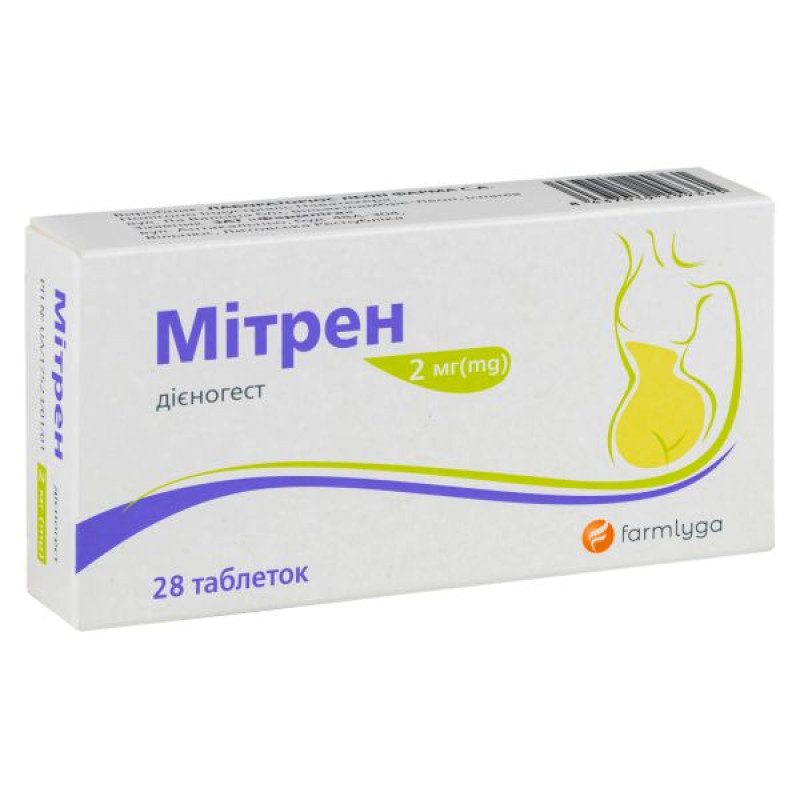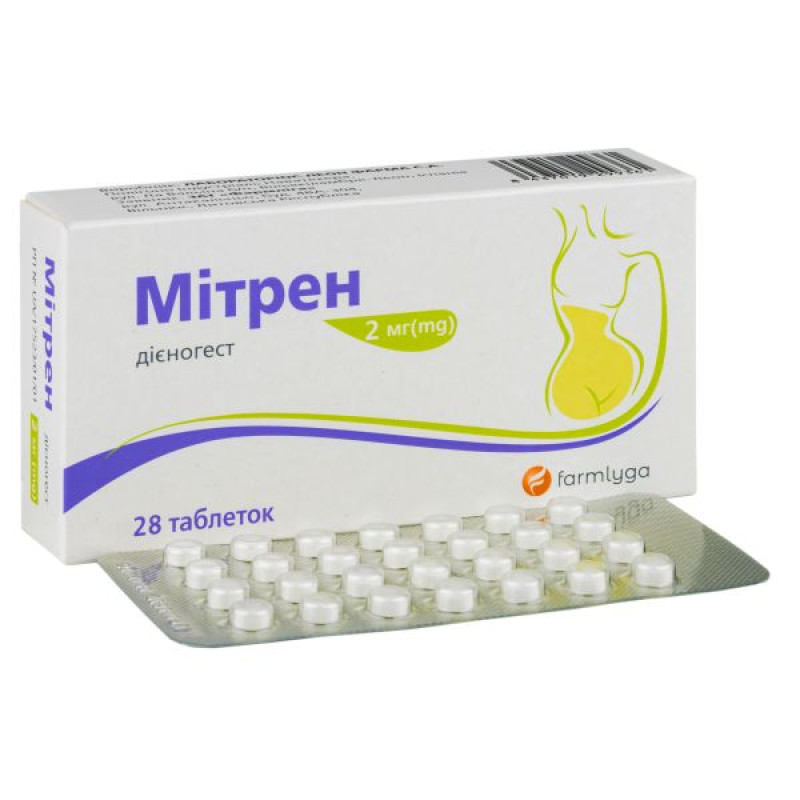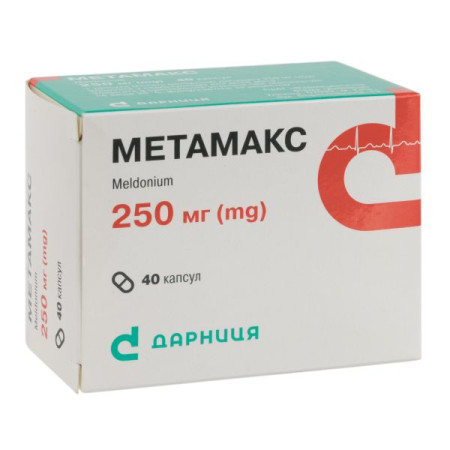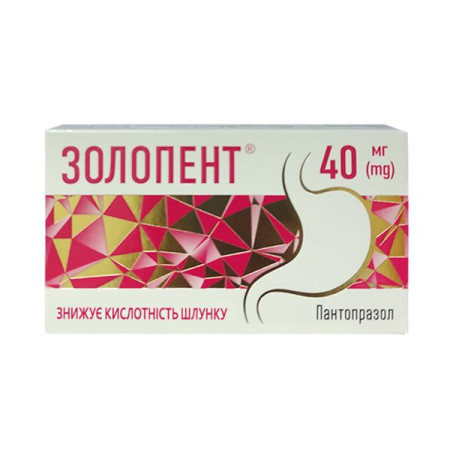Mitren tablets 2mg blister No. 28

Instructions for use Mitren tablets 2mg blister No. 28
Composition
active ingredient: dienogest;
1 tablet contains dienogest 2 mg;
excipients: lactose monohydrate; corn starch; povidone K-30; magnesium stearate.
Dosage form
Pills.
Main physicochemical properties: white round flat tablets.
Pharmacotherapeutic group
Drugs affecting the genitourinary system and sex hormones. Sex gland hormones and drugs used in genital pathology. Progestogens. Pregnadiene derivatives.
ATX code G03D B08.
Pharmacological properties
Pharmacodynamics
Dienogest is a nortestosterone derivative without androgenic and with some antiandrogenic activity, which is approximately one third of the activity of cyproterone acetate. Dienogest binds to progesterone receptors in the uterus with only 10% relative affinity. Despite its low affinity for progesterone receptors, dienogest has a strong progestogenic effect in vivo. Dienogest does not exhibit significant androgenic, mineralocorticoid or glucocorticoid activity in vivo.
Dienogest affects endometriosis by reducing endogenous estradiol production and thus inhibiting the trophic effects of estradiol on eutopic and ectopic endometrium. With continuous use, dienogest leads to the creation of a hypoestrogenic, hypergestagenic endocrine environment, which causes initial decidualization of endometrial tissue with subsequent atrophy of endometrioid foci.
Performance data
The superiority of dienogest over placebo was demonstrated in a study involving patients with endometriosis. Pelvic pain associated with endometriosis was measured using a visual analogue scale (0-100 mm). Due to
After 3 months of dienogest therapy, a statistically significant difference compared to placebo (D = 12.3 mm; p<0.0001) and a clinically significant reduction in pain compared to baseline (mean reduction = 27.4 mm ± 22.9) were observed.
After 3 months of treatment, a reduction of pelvic pain associated with endometriosis by 50% or more was achieved in 37.3% of patients receiving dienogest (placebo: 19.8%) without a corresponding increase in the dose of concomitant analgesic; a reduction of pelvic pain associated with endometriosis by 75% or more (also without a corresponding increase in the dose of concomitant analgesic) was achieved in 18.6% of patients receiving dienogest (placebo: 7.3%).
An extension of this study showed continued reduction in endometriosis-related pelvic pain with treatment durations of up to
15 months.
These findings were supported by results from another study comparing dienogest with a gonadotropin-releasing hormone agonist in patients with endometriosis.
Data from three studies involving patients receiving dienogest 2 mg daily indicate a significant reduction in endometrioid lesions after 6 months of treatment.
In a small study, dienogest at a dose of 1 mg/day showed no ovulation after 1 month of therapy. Dienogest has not been studied for contraceptive efficacy in larger studies.
Safety data
Endogenous estrogen levels are only moderately suppressed during treatment with dienogest.
Long-term results of studies of bone mineral density (BMD) and fracture risk in patients using dienogest are not yet available. BMD was assessed in adult patients before and after 6 months of treatment with dienogest. No decrease in mean BMD was observed. In 29 patients receiving leuprorelin acetate, a mean decrease of 4.04% ± 4.84 was observed over the same period (D between groups = 4.29%, p < 0.0003).
No significant effects on standard laboratory parameters, including blood count, blood chemistry, liver enzyme levels, lipid levels, and HbA1C, were observed during treatment with dienogest for 15 months.
The safety of dienogest on BMD in adolescents was assessed in a 12-month study in adolescent patients (12 to 18 years of age) with clinically suspected or confirmed endometriosis. The mean relative change in BMD of the lumbar spine (L2–L4) from baseline in patients to the end of treatment was -1.2%. Repeated measurements 6 months after the end of treatment in the subgroup with decreased BMD values showed an increase in BMD to -0.6%.
Pharmacokinetics
Absorption
After oral administration, dienogest is rapidly and completely absorbed. The maximum serum concentration is reached within 1.5 hours after a single oral dose and is 47 ng/ml. The bioavailability of dienogest is approximately 91%. The pharmacokinetics of dienogest are dose-dependent in the dose range of 1-8 mg.
Distribution
Dienogest is bound to serum albumin and does not bind to sex steroid binding globulin (SSGB) or corticoid binding globulin (CBG). Only 10% of the total serum concentration of dienogest is found as free steroid, and 90% is non-specifically bound to albumin. The apparent volume of distribution of dienogest is 40 l.
Dienogest is completely metabolized by the known steroid metabolism pathways, with the formation of mainly endocrinologically inactive metabolites. Based on in vitro and in vivo studies, CYP3A4 is the main enzyme involved in the metabolism of dienogest. These metabolites are very rapidly eliminated from plasma such that the dominant metabolite in plasma is dienogest in unchanged form.
The clearance rate from blood serum is 64 ml/min.
Breeding
The serum level of dienogest decreases in a biphasic manner with a half-life of 9-10 hours. Dienogest is excreted as metabolites in urine and feces in a ratio of approximately 3:1 after oral administration of 0.1 mg/kg. The half-life of metabolites in urine is approximately 14 hours. After oral administration, 86% of the administered dose is excreted from the body within 6 days, most of this amount is excreted in the first 24 hours, mainly in urine.
State of equilibrium
The pharmacokinetics of dienogest are independent of the level of GSH. With daily administration, the concentration of the substance in the blood serum increases by 1.24 times, reaching an equilibrium state after 4 days of use. The pharmacokinetics of dienogest after repeated use of Mitren can be predicted based on data on the pharmacokinetics of a single dose.
Pharmacokinetics in special patient groups
The pharmacokinetics of dienogest have not been studied in patients with renal impairment.
The pharmacokinetics of dienogest have not been studied in patients with hepatic impairment.
Indication
Treatment of endometriosis.
Contraindication
Mitran should not be used if any of the following conditions or diseases are present. This information is partly based on the use of other progestogen-only products. If any of these conditions or diseases appear for the first time while using Mitran, it should be stopped immediately.
Active venous thromboembolism. Current or history of arterial or cardiovascular disease (e.g. myocardial infarction, cerebrovascular accident, ischemic heart disease). Diabetes mellitus with vascular disease. Current or history of severe liver disease until liver function tests return to normal. Current or history of liver tumors (benign or malignant). Known or suspected sex hormone-dependent malignant tumors. Vaginal bleeding of unknown etiology. Hypersensitivity to the active substance or to any of the components of the drug.
Interaction with other medicinal products and other types of interactions
Note: To identify possible interactions, consult the instructions for medical use of concomitantly used medications.
Effects of other drugs on dienogest
Progestogens, including dienogest, are metabolized primarily by the cytochrome P450 3A4 (CYP3A4) system, which is located in the intestinal mucosa and in the liver. Therefore, inducers or inhibitors of CYP3A4 may affect progestogen metabolism.
Increased clearance of sex hormones due to enzyme induction may reduce the therapeutic effect of Mitran and lead to undesirable effects, such as changes in the pattern of menstrual bleeding.
Reduced clearance of sex hormones due to enzyme inhibition may reduce the therapeutic effect of Mithren and lead to the development of adverse reactions.
Substances that increase the clearance of sex hormones (reduced efficacy by enzyme induction), such as phenytoin, barbiturates, primidone, carbamazepine, rifampicin, and possibly oxcarbazepine, topiramate, felbamate, griseofulvin and products containing St. John's wort (Hypericum perforatum).
Enzyme induction may occur after a few days of therapy. Maximum enzyme induction is generally seen after a few weeks.
Enzyme induction may persist for up to 4 weeks after discontinuation of therapy.
The effect of the CYP 3A4 inducer rifampicin was studied in healthy postmenopausal women. Co-administration of rifampicin with estradiol valerate/dienogest tablets resulted in a significant decrease in the steady-state concentration and systemic exposure of dienogest and estradiol. The steady-state systemic exposure of dienogest and estradiol, as measured by AUC (0–24 hours), was reduced by 83% and 44%, respectively.
Substances with different effects on the clearance of sex hormones.
Concomitant use of a large number of HIV protease inhibitor and non-nucleoside reverse transcriptase inhibitor combinations with sex hormones, in combination with hepatitis C virus inhibitor combinations, may increase or decrease progestin plasma levels. The cumulative effect of these changes may be clinically significant in some cases.
Substances that reduce the clearance of sex hormones (enzyme inhibitors).
In a study evaluating the effect of CYP 3A4 inhibitors (ketoconazole, erythromycin) on the combination of estradiol valerate/dienogest, steady-state plasma concentrations of dienogest were increased. Co-administration of the potent inhibitor ketoconazole resulted in a 186% increase in the mean area under the plasma concentration-time curve of dienogest (0-24 hours). Co-administration of the moderate inhibitor erythromycin resulted in a 62% increase in the AUC (0-24 hours) of dienogest. The clinical significance of these interactions is unknown.
Effect of dienogest on other medicinal products
Based on the results of in vitro inhibition studies, clinically significant interactions of dienogest with other drugs metabolized by cytochrome P450 enzymes are unlikely.
Interaction with food products
Consumption of a high-fat meal did not affect the bioavailability of dienogest.
Laboratory tests
The use of progestogens may affect the results of some laboratory tests, including biochemical parameters of the liver, thyroid gland, renal and adrenal function, the level of proteins (carriers) in the blood plasma (e.g. GSK and lipid/lipoprotein fractions), parameters of carbohydrate metabolism and indicators of coagulation and fibrinolysis. Changes usually remain within the laboratory norm.
Application features
Reservation
Since Mithren is a progestogen-only preparation, it is considered that the special warnings and precautions for the use of progestin-containing preparations also apply to this preparation, although not all warnings and precautions are based on the relevant results of clinical studies with this particular substance.
If any of the following conditions/risk factors worsen or first appear, an individual benefit/risk analysis should be performed before initiating or continuing the use of Mitran.
Heavy uterine bleeding
Uterine bleeding, for example in women with uterine adenomyosis or uterine leiomyoma, may increase with dienogest. If the bleeding is severe and does not stop for a long time, it may lead to anemia (in some cases - severe). In this case, the question of stopping the drug should be considered.
Change in bleeding pattern
Treatment with dienogest affects the pattern of menstrual bleeding in most women (see section "Adverse reactions").
Circulatory disorders
There is limited evidence from epidemiological studies of an association between the use of progestogen-only contraceptives and an increased risk of myocardial infarction or cerebral thromboembolism. The risk of cardiovascular and cerebral events is more likely to be related to age, hypertension and smoking. In women with hypertension, the risk of stroke may be slightly increased with the use of progestogen-only contraceptives.
Data from some studies suggest a certain, but not statistically significant, increased risk of venous thromboembolism (deep vein thrombosis, pulmonary embolism) associated with the use of progestogen-only products. Generally recognized factors that increase the risk of venous thromboembolism (VTE) include: personal or family history (e.g., VTE in siblings or parents at a relatively young age); age; obesity, prolonged immobilization, major surgery or trauma. In the event of prolonged immobilization, it is recommended to discontinue the use of Mitran (for elective surgery - at least 4 weeks before it) and not to restart it earlier than 2 weeks after complete rehabilitation.
The increased risk of thromboembolism in the postpartum period should be taken into account.
If symptoms of venous and arterial thrombotic diseases occur or are suspected, treatment should be discontinued.
Tumors
In isolated cases, benign and, even more rarely, malignant liver tumors have been observed in women taking hormonal agents similar to those contained in Migraine, which in some cases have led to life-threatening intra-abdominal bleeding. In the event of complaints of severe epigastric pain, liver enlargement or signs of intra-abdominal bleeding, the possibility of a liver tumor should be considered in the differential diagnosis in women taking dienogest.
Osteoporosis
In patients at increased risk of osteoporosis, a careful benefit/risk assessment should be performed before initiating treatment with dienogest, as endogenous estrogen levels are moderately reduced during treatment with this drug (see section 5.1).
The use of dienogest in adolescents (12–18 years) during a treatment period of 12 months was associated with a decrease in mean BMD at the lumbar spine (L2–L4) of 1.2%. After discontinuation of treatment, BMD increased again in these patients.
The mean relative change in BMD from baseline to end of treatment was 1.2% with a range between -6% and 5%. Repeat measurement 6 months after end of treatment in the subgroup with reduced BMD values showed a trend towards recovery (mean relative change from baseline: -2.3% at end of treatment and -0.6% at 6 months after end of treatment with a range between -9% and 6%).
BMD loss is of particular importance during adolescence and early puberty, a critical period of bone growth. It is unknown whether BMD reduction in this population will reduce peak bone mass and increase the risk of bone fracture in old age (see sections 5.1 and 5.2).
Before starting treatment, the doctor should weigh the benefits of using dienogest and the possible risks of use for each individual adolescent, also taking into account the presence of significant risk factors for osteoporosis.
Adequate intake of calcium and vitamin D through diet or supplementation is important for bone health in women of all ages.
No decrease in BMD was observed in adults (see section "Pharmacological properties").
Other states
Patients with a history of depression should be carefully monitored and the drug should be discontinued if severe depression develops.
Dienogest usually does not affect blood pressure in normotensive women. However, if prolonged, clinically significant arterial hypertension occurs during use of the drug, it is recommended to discontinue the drug and treat the arterial hypertension.
If cholestatic jaundice and/or pruritus that occurred during pregnancy or previous use of sex hormones recur, the drug should be discontinued.
Dienogest may have a minor effect on peripheral insulin resistance and glucose tolerance. Women with diabetes, especially those with a history of gestational diabetes, should be carefully monitored during use of dienogest.
Chloasma may occasionally develop, especially in women with a history of chloasma during pregnancy. Women prone to chloasma should avoid exposure to direct sunlight or ultraviolet radiation while taking dienogest.
The risk of ectopic pregnancy in women using progestogen-only contraceptives is higher than in women using COCs. Therefore, in women with a history of ectopic pregnancy or tubal dysfunction, the use of dienogest should be considered only after a careful assessment of the benefit/risk ratio.
Persistence of follicles (often referred to as functional ovarian cysts) may occur during dienogest use. Most of these follicles are asymptomatic, although some may be accompanied by pelvic pain.
Not used in geriatric practice.
Lactose
One tablet of the drug Mitren contains 60.93 mg of lactose monohydrate. Patients with rare hereditary diseases associated with galactose intolerance, the Lapp lactase deficiency or glucose-galactose malabsorption who are on a lactose-free diet should take into account the amount of this substance in the tablet of the drug Mitren.
Ability to influence reaction speed when driving vehicles or other mechanisms
No effects on the ability to drive and use machines were observed in patients taking drugs containing dienogest.
Use during pregnancy or breastfeeding
Pregnancy
There are limited data from the use of dienogest in pregnant women. Animal studies do not indicate direct or indirect reproductive toxicity (see section 5.1).
Mithren is not recommended for use in pregnant women, as there is no need to treat endometriosis during pregnancy.
Treatment with dienogest during breastfeeding is not recommended. It is not known whether dienogest is excreted in human milk. Animal data indicate that dienogest is excreted in human milk. A decision must be made whether to discontinue breast-feeding or to discontinue dienogest therapy taking into account the benefit of breast-feeding for the child and the need for therapy for the woman.
Fertility
Based on the available data, it can be stated that during treatment with dienogest, ovulation is inhibited in most patients. However, the drug Mithren is not a contraceptive.
If contraception is required, a non-hormonal method of contraception should be used in addition (see section “Method of administration and dosage”).
Based on the available data, it can be stated that the menstrual cycle returns to normal within 2 months after discontinuation of dienogest treatment.
Method of administration and doses
Method of application
For oral use.
Dosage
Take 1 tablet daily without a break in taking the drug at about the same time, with a small amount of liquid. The tablets can be taken regardless of meals.
The tablets should be taken regularly, regardless of menstrual bleeding. As soon as the tablets from one package are finished, start taking the tablets from the next package without taking a break in taking the medicine.
There is no experience with dienogest in patients with endometriosis for longer than 15 months.
You can start taking the drug on any day of the menstrual cycle.
The use of any hormonal contraceptives should be discontinued before starting therapy with Mitran. If contraception is necessary, a non-hormonal method of contraception (e.g., a barrier method) should be used in addition.
Skipping a medication
In case of missed tablets, vomiting and/or diarrhoea (which occurred during
3-4 hours after taking the tablet), the effectiveness of the drug Mitren may be reduced. In case of missing one or more tablets, the first tablet should be taken as soon as the woman remembers, and the next one should be taken at the usual time. Similarly, a tablet that was not absorbed due to vomiting or diarrhea should be replaced with another tablet.
Additional information regarding use in special patient groups
Elderly patients
There are no relevant indications for the use of the drug Mitren in patients in this group.
Liver failure
The drug is contraindicated in patients with current or history of severe liver disease (see section "Contraindications").
Kidney failure
There are no data indicating the need for dose adjustment for patients with renal insufficiency.
Children
The drug Mitren is not indicated for use in children before the onset of menarche.
There is evidence of the efficacy of dienogest in the treatment of endometriosis associated with pelvic pain in adolescents (12–18 years) with an overall favorable safety and tolerability profile of the drug.
The physician should weigh the benefits of dienogest use against the possible risks of use for each individual adolescent (see sections “Pharmacodynamics”, “Special precautions for use”).
Overdose
Acute toxicity studies conducted with dienogest did not indicate a risk of acute adverse reactions in the event of inadvertent administration of several daily therapeutic doses. No specific antidotes exist. The use of 20-30 mg of dienogest per day (which is 10-15 times higher than the dose in a Mitran tablet) for more than 24 weeks was very well tolerated.
Adverse reactions
Adverse reactions are described according to MedDRA.
Adverse reactions most often develop during the first months of dienogest use and disappear during treatment. Changes in bleeding patterns, such as spotting, irregular bleeding or amenorrhea, may occur.
The following adverse reactions have been reported during treatment with dienogest. The most frequently reported adverse reactions during treatment with dienogest include headache (9.0%), breast discomfort (5.4%), depressed mood (5.1%) and acne (5.1%).
In addition, dienogest treatment affects the menstrual bleeding pattern in most women. The menstrual bleeding pattern was systematically assessed using patient diaries and analyzed using the WHO method during a 90-day reporting period. During the first 90 days of treatment, the following bleeding patterns were observed: amenorrhea (1.7%), infrequent bleeding (27.2%), frequent bleeding (13.4%), irregular bleeding (35.2%), prolonged bleeding (38.3%), normal menstrual bleeding, i.e. none of the previous categories (19.7%). During the fourth reporting period, the following bleeding patterns were observed: amenorrhea (28.2%), infrequent bleeding (24.2%), frequent bleeding (2.7%), irregular bleeding (21.5%), prolonged bleeding (4.0%), normal menstrual bleeding, i.e. none of the previous categories (22.8%). Changes in menstrual bleeding patterns have only occasionally been reported as adverse reactions in female patients (see table of adverse reactions).
Within each grouping, adverse reactions are listed in order of decreasing frequency: common (≥ 1/100 to < 1/10) and uncommon (≥ 1/1000 to < 1/100). The frequencies are based on pooled data from four clinical trials.
| Organ systems (MedDRA) | Often | Infrequently |
| Blood and lymphatic system disorders | anemia | |
| Metabolism and metabolic disorders | weight gain | weight loss, increased appetite |
| Mental disorders | depressed mood, sleep disturbances, nervousness, decreased libido, mood swings | anxiety, depression, mood lability |
| From the nervous system | headache, migraine | impaired autonomic regulation, impaired attention |
| From the organs of vision | dry eyes | |
| From the side of the organs of hearing and vestibular apparatus | tingle | |
| From the heart | nonspecific circulatory disorders, increased heartbeat | |
| From the vascular side | arterial hypotension | |
| Respiratory, thoracic and mediastinal disorders | dyspnea | |
| Gastrointestinal tract | nausea, abdominal pain, flatulence, bloating, vomiting | diarrhea, constipation, abdominal discomfort, gastrointestinal inflammation, gingivitis |
| Skin and subcutaneous tissue disorders | acne, alopecia | dry skin, hyperhidrosis, itching, hirsutism, onychoclasia, dandruff, dermatitis, hair growth disorders, photosensitivity reactions, pigmentation changes |
| Musculoskeletal and connective tissue disorders | back pain | bone pain, muscle cramps, pain in limbs, feeling of heaviness in limbs |
| Renal and urinary disorders | urinary tract infections | |
| Reproductive system and breast disorders | breast discomfort, ovarian cyst, hot flashes, uterine/vaginal bleeding, including spotting | vaginal candidiasis, vulvar and vaginal dryness, genital discharge, pelvic pain, atrophic vulvovaginitis, breast enlargement, cystic fibrosis of the breasts, breast engorgement |
| General disorders and local reactions | asthenic conditions, irritability | edema |
The following adverse reactions were also observed: follicle persistence, increased appetite, hypersensitivity reactions.
Other serious adverse reactions have been observed during the use of steroid sex hormones and progestogens (see section "Special warnings and precautions for use"): venous and arterial thromboembolic disorders, arterial hypertension, myocardial infarction, stroke, breast neoplasms, liver tumors, back discomfort, chloasma, cholestatic jaundice, osteoporosis, changes in glucose tolerance or effects on peripheral insulin resistance.
Reporting of suspected adverse reactions
Reporting of suspected adverse reactions during post-marketing surveillance is very important. This allows monitoring of the benefit/risk balance of medicinal products. Healthcare professionals should report suspected adverse reactions.
Expiration date
3 years.
Storage conditions
Store in original packaging at a temperature not exceeding 25 ° C. Keep out of the reach of children.
Packaging
28 tablets in a blister; 1 blister in a cardboard box.
Vacation category
According to the recipe.
Producer
LABORATORIOS LEON PHARMA S.A.
Location of the manufacturer and its business address
Poligono Industrial Navatechera, La Vallina Street, Villaquilambre-León, Spain.
There are no reviews for this product.
There are no reviews for this product, be the first to leave your review.
No questions about this product, be the first and ask your question.
















